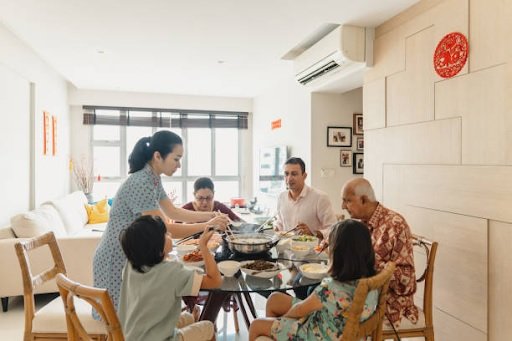The dining table is often considered the heart of the home, a place where families and friends gather to share meals, and conversations, and create lasting memories. In Singapore, where space can be a premium, choosing the right dining table involves careful consideration of various factors to ensure it fits both your lifestyle and living space. This article explores the essential aspects of selecting the perfect dining table in Singapore, from size and shape to materials and style, helping you make an informed decision that enhances your home’s functionality and aesthetic appeal.
Understanding Your Space
Before diving into the myriad options available, it’s crucial to assess the space where the dining table will reside. In Singapore, where homes range from compact apartments to spacious landed properties, understanding your space constraints and layout is the first step.
1. Measure Your Space: Accurately measure the area designated for the dining table Singapore. Ensure there is enough room for chairs to be pulled out comfortably and for people to move around without feeling cramped. A good rule of thumb is to leave at least 90 cm of space around the table for movement.
2. Consider the Flow: Think about how the dining area connects with other parts of your home. Ensure that the placement of the table does not obstruct pathways or create a cluttered look. In open-plan layouts, the dining table often serves as a transitional element between the kitchen and living areas.
Choosing the Right Size
The size of the dining table is one of the most critical factors in ensuring it fits well within your space and meets your needs.
1. Seating Capacity: Determine how many people you need to accommodate regularly. For larger gatherings, consider an extendable table that can be adjusted as needed. A table that seats four to six people is typically adequate for most families, while larger households or those who entertain frequently might opt for tables that seat eight or more.
2. Table Dimensions: Standard table dimensions vary, but generally, a rectangular table for four people measures around 120 cm x 75 cm, while a six-seater is about 180 cm x 90 cm. Round tables for four typically have a diameter of 100-120 cm.
Selecting the Shape
The shape of your dining table can influence the dining experience and how well it fits into your space.
1. Rectangular: Rectangular tables are the most common and versatile shape, offering ample surface area and fitting well in most dining rooms. They are ideal for narrow spaces and can accommodate more people by adding extra chairs on the sides.
2. Square: Square tables work well in square rooms and provide an intimate dining experience. They are best suited for smaller gatherings, usually seating four to six people.
3. Round: Round tables create a more intimate and inclusive atmosphere, encouraging conversation as everyone faces each other. They are ideal for smaller spaces and can seat four to eight people, depending on the diameter.
4. Oval: Oval tables combine the benefits of rectangular and round tables, offering a large surface area with a softer look. They can seat more people without taking up as much visual space as a rectangular table.
Material Considerations
The material of the dining table not only affects its durability and maintenance but also its aesthetic appeal.
1. Wood: Wooden tables are timeless and versatile, fitting both traditional and contemporary interiors. Hardwood options like oak, walnut, and teak are durable and have a natural beauty, but they can be expensive. Softwoods like pine are more affordable but less durable.
2. Glass: Glass tables create a modern, airy feel and are great for smaller spaces as they make the room appear larger. However, they require regular cleaning and can be prone to scratches and cracks.
3. Metal: Metal tables, often with glass or wood tops, offer a sleek, industrial look. They are durable and easy to clean but can be heavy and may not suit all interior styles.
4. Marble: Marble tables exude luxury and elegance, making a bold statement in any dining room. They are durable but require careful maintenance to avoid staining and scratching.
5. Laminate and Veneer: These materials offer the look of wood at a lower cost. Laminate is highly durable and easy to clean, while veneer provides a more authentic wood appearance but can be less durable than solid wood.
Style and Aesthetic
The style of the dining table should complement your home’s decor and personal taste.
1. Traditional: Traditional dining tables often feature ornate designs, rich wood tones, and intricate details. They are well-suited for classic or formal dining rooms.
2. Modern: Modern tables boast clean lines, minimalistic designs, and materials like glass and metal. They fit well in contemporary homes with sleek, uncluttered aesthetics.
3. Rustic: Rustic tables emphasize natural materials and a handcrafted look, often featuring distressed wood and a more casual vibe. They are perfect for creating a cosy, welcoming atmosphere.
4. Industrial: Industrial tables combine raw materials like metal and reclaimed wood, creating a robust and edgy look. They work well in loft-style or urban interiors.
5. Scandinavian: Scandinavian design is characterized by simplicity, functionality, and natural elements. Tables in this style often feature light wood, clean lines, and a minimalist approach.
Practical Features
Beyond aesthetics and size, consider practical features that enhance the functionality of your dining table.
1. Extendable Tables: These tables are ideal for those who entertain frequently or have varying seating needs. They can be compact for daily use and expanded for larger gatherings.
2. Storage Options: Some dining tables come with built-in storage, such as drawers or shelves, which can be handy for storing table linens, cutlery, and other dining essentials.
3. Height Adjustability: Adjustable-height tables offer versatility, allowing you to change the table height to suit different activities, from dining to working.
Maintenance and Durability
Choose a table that fits your lifestyle in terms of maintenance and durability.
1. Easy to Clean: For families with young children, a table that is easy to clean and resistant to stains and scratches is essential. Materials like laminate, glass, and certain types of finished wood can be easier to maintain.
2. Durability: Consider the table’s durability, especially if it will see heavy use. Hardwood tables, while more expensive, offer superior longevity.
Selecting the perfect dining table in Singapore involves balancing aesthetics, functionality, and space considerations. From understanding your space constraints to choosing the right size, shape, material, and style, every aspect plays a crucial role in ensuring the table fits your needs and enhances your home. Practical features like extendability and built-in storage add to the table’s functionality, while easy maintenance and durability ensure it remains a central part of your home for years to come. By carefully evaluating these factors, you can make an informed decision that brings both joy and practicality to your dining experience, creating a welcoming space for meals and memories with family and friends.


